Automated soil moisture sensor
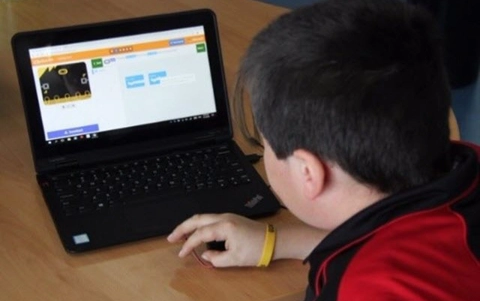
About this lesson
The soil moisture sensor project integrates science understandings and computational thinking to solve a problem about sustainable watering practices. This lesson was devised by Trudy Ward, Clarendon Vale Primary School, Tasmania.
Year band: 3-4, 5-6
Curriculum Links AssessmentCurriculum Links
Links with Digital Technologies Curriculum Area.
| 3-4 |
Define problems with given design criteria and by co-creating user stories Follow and describe algorithms involving sequencing, comparison operators (branching) and iteration (AC9TDI4P02) |
|---|---|
|
Implement simple algorithms as visual programs involving control structures and input (AC9TDI4P04) Discuss how existing and student solutions satisfy the design criteria and user stories (AC9TDI4P05) |
|
| 5-6 |
Design algorithms involving multiple alternatives (branching) and iteration |
|
Implement algorithms as visual programs involving control structures, variables and input (AC9TDI6P05) |
|
| Year | Content Description |
Links with Design and Technology Curriculum Area.
| 3–4 |
Explore needs or opportunities for designing, and test materials, components, tools, equipment and processes needed to create designed solutions (AC9TDE4P01) |
|---|---|
|
Use given or co-developed design criteria including sustainability to evaluate design ideas and solutions (AC9TDE4P04) |
|
| 5-6 |
Investigate needs or opportunities for designing, and the materials, components, tools, equipment and processes needed to create designed solutions (AC9TDE6P01) |
|
Negotiate design criteria including sustainability to evaluate design ideas, processes and solutions (AC9TDE6P04) |
|
| Year | Content Description |
Links with Science Curriculum Area.
| 4 |
Explain the roles and interactions of consumers, producers and decomposers within a habitat and how food chains represent feeding relationships (AC9S4U01) |
|---|---|
| 5 |
Examine how particular structural features and behaviours of living things enable their survival in specific habitats (AC9S5U01) |
| Row | Content Description |
Assessment
A celebration of learning enables students to show other teachers, peers and community their solution. This also forms part of their assessment; their ability to communicate their design process and product.
A rubric is one form of summative assessment you can use to determine students' processes and evaluate their success.
Students can keep a design journal for assessment, detailing their design steps and progress for assessment.
All of the project's assessments are based upon the Australian Curriculum: Digital Technologies achievement standards. The heart of the project is how the Digital Technologies curriculum integrates with students' understanding of real-world problems and, through decomposing those problems, how the students identify key elements and factors that enable them to find potential solutions not possible by using algorithms, programming and digital systems to bring about change (Curran, 2017). Students also show the ability to work as part of a team, with some autonomy.
Learning intentions
- Investigate factors that affect plant growth.
- Collect data using a sensor.
- Program coding software to automate the watering of a plant.
- Evaluate the results of the watering system.
Suggested steps
![]()
![]()
Anxiety/ Additional scaffolding:
Cater for students with social/emotional challenges. Consider adjustments to ensure that students facing these challenges feel comfortable while completing the project.
Remember that you can make adjustments to lighting and room noise levels.
Consider an initial meeting with students to discuss the project and their needs. For students with autism spectrum disorder (ASD), this will support the scaffolding of necessary social stories and routines so the students will be able to participate to the best of their ability. Duncan, Ruble, Thomas & Stark (2017) discuss how crucially important the creation of an environment that includes pedagogical practices of scaffolding and reinforcement is to students with ASD remaining engaged in school.
Other students in the class may have behavioural issues and come from all-too-common trauma backgrounds. You can also meet their needs through close consultation over their learning plan, and through the practice of calmer classrooms trauma pedagogies to ensure a calm, safe space where they feel valued and respected. The aim is to create a hands-on inquiry environment where a culture of measured risk-taking within the task is accepted and encouraged (Geary, 2007).
- Identifying the problem
Engage students in the project by using a relevant hook (such as a visit to a local garden, school vegetable garden, agricultural farm or similar context) to discuss sustainable watering practices. Discuss an automated process (such as one using a sensor to gather data about soil moisture) and how this might work.
- Investigating and defining
Using a collaborative approach and a teacher as facilitator, pose the problem in the form of this question: ‘How can we achieve optimal plant growth using sustainable water practices?’
Students investigate and define the problem, considering the germination and growth of plants. To solve this real-world problem, they brainstorm and research potential solutions using the internet and graphic organisers – such as mind maps or ‘T’ charts – to communicate what they currently see, and what they expect to see. Albion, Campbell & Jobling (2018) support this type of collaborative inquiry, and this pedagogical practice, as it provides students with necessary enterprise skills required for real-world projects.
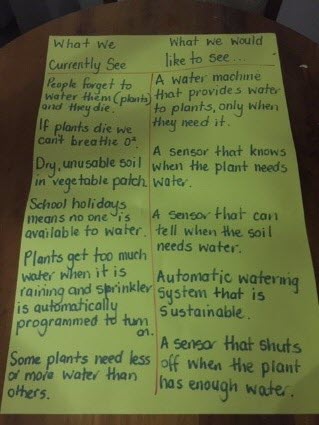
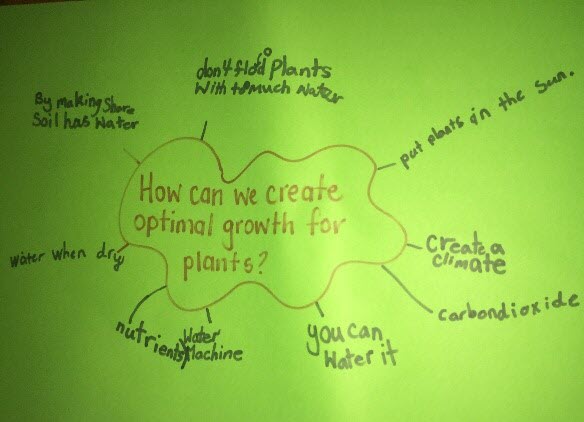
Credit: Trudy Ward
- In each group, students should give consideration to each other’s ideas, skill sets and preferences. This will help to determine both the type of solution they would like to create and how they could realistically achieve the necessary processes required to create a product suitable for its intended purpose.
- Generating and designing
Encourage students to decide on an approach to implementing their digital solution through a process of elimination. This process should consider affordability and other relevant criteria, which may include ease of use/programming. Ask students to justify their choice. For example, a suitable solution may include BBC micro:bit and Grove Seeed kit to create a soil moisture sensor for data collection. Justification may include the ability to analyse and evaluate data for the purpose of keeping the soil moisture at optimal levels for seedling germination and growth.
- Discuss approaches such as peer assessment of the coding to ensure that errors are mitigated and that a collaborative approach is used to build mutual friendship and trust. Through becoming aware of a problem, identifying a data source and proposing an automated sensor, students are using computational thinking. They are allowing their current thoughts, learnings and outcomes to be transformed through coding, which requires a precise form of language to enable a system to operate (Henderson & Romeo, eds, 2015).
- Discuss assessment criteria for the project and develop a rubric to ensure students have input into each of the key stages of the design project. The rubric can increase productivity if students refer to it at any stage to monitor their progress and to help them stay on track.
- Producing and implementing
In this example it is suggested students use a programming board such as the BBC micro:bit. Students can use the Makecode website to create code for their project using visual programming. Micro:bit enables the use of sensors.
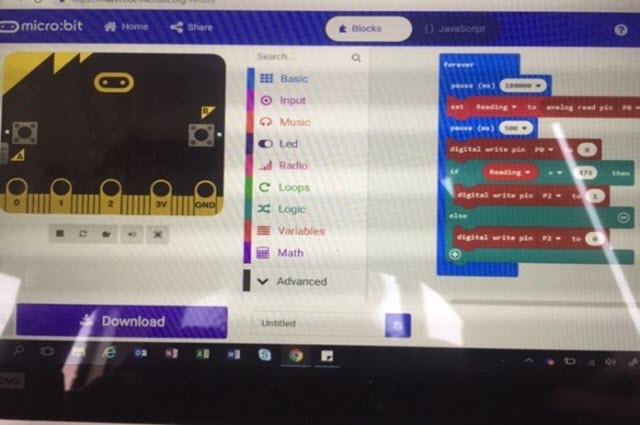
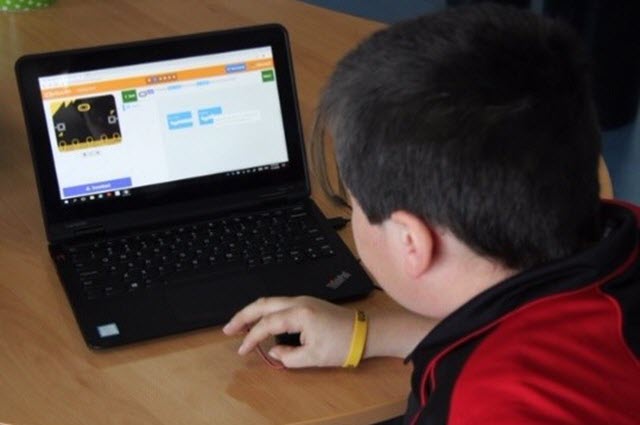
Credit: Trudy Ward Makecode user interface and student programming
The first stage is to program their Micro:bit to gather data on moisture level.
A sample program is provided to help guide students with the process.
-
Teacher reflection
Firstly they gathered all their resources and began the coding journey. They then completed stage 1 of the soil moisture sensor. Once they evaluated the project as successful and they grew in confidence, the students extended their learning to create an automated product of an automated soil moisture sensor, able to collect, analyse and evaluate soil moisture levels to maintain optimal soil conditions for seedlings. Many ups and downs, including modifying coding, changing the water levels, glass circumference, stick length and tape used all enabled students to complete the project authentically, as in the real world.
One interesting inclusion was the millisecond wait coded by the students, with the intention of preventing constant current in the sensor and preventing the grove sensor from corroding. This was an unexpected but very welcome learning. Make code was a great scaffold for the students as it allowed them to check their code and refer back whilst extending them to look at it in written form also. Saeli, Perrenet, Jochems & Zwaneveld (2011) support this pedagogy as they also believe that programming using scaffolds is beneficial to students’ mastery of coding.
During the project, the students enjoyed discussing how incompetent (when compared with machines) humans are at understanding plant needs, and how emotion and consistency play a huge part in whether most gardens will flourish. This is supported by Turing (1950) who discussed a machine's accuracy over humans.
- Evaluating
Students test their soil moisture sensor with a pot plant and evaluate how well the system works.
Teacher reflection
The moisture levels are steady and the seedling, at this early stage, seems to be progressing well. How well the product solves the problem is yet to be fully determined. Although initially it seems successful, just how efficient it is with battery life and design will need to be determined over a longer period of time, along with its functionality in relation to environmental, social and economic conditions. Engagement in the project was amazing. This type of wicked problem-based project is supported by Mishra & Koehler (2008), who discuss the increased engagement when the technologies, approaches and goals all connect.
This type of approach is why the students saw the project as a success and also why, through their enthusiasm and discussions with peers outside the project group, other students have shown interest in being a part of the next one.
Future ideas and modifications
Students may discuss or implement changes or modifications, for example:
- Incorporate a solar panel attachment to the battery, so the battery will continually charge and not go flat.
- Conduct the test using the sensor in multiple conditions such as the glasshouse, the classroom and outside to see the extent to which other environmental factors affect plant growth.
Teacher reflection
The project lacked enough time for a full appreciation of the usability of the sensor, as five sessions were not long enough for the students to fully analyse and evaluate their project.
With extended time, the project would include the following: quantum quizzes to help students understand the concepts (Project Quantum, 2018); student creation of flow charts and algorithms for the sensor; student analysis of the data presented over time – from plant growth in multiple conditions (see above for extension to project ideas); and having the students ascertain from the investigation which conditions best suited the sensors and plant growth.
Future planning for this type of project would encourage a full term of weekly 60-minute lessons to ensure enough time for each part of the design process and student movement between each element as required.
Discussion
Digital Technology focus
- What did you learn as you created your program to automate the watering of a plant?
- What parts of the code did you use to connect and operate the sensor?
- How is your digital solution sustainable?
Science focus
- What did your investigation of plant germination and growth reveal?
- How much water does a plant need and how did you find that out?
Why is this relevant?
Implementation
Students implement simple digital solutions as visual programs with algorithms involving branching (decisions) and user input.
First, some definitions:
Branching
Implementing a decision in a programming language, usually using an ‘if’ or ‘if-else’ statement.
Students can create programs that include some form of decision, such as writing simple if-statements.
User input
Receiving data from the user (via a sensor or direct input with a keyboard, mouse of other input device) and using that data in code.
In this program, students gather data using a moisture sensor. This data is then used to execute some action.
In years 5–6, students are also expected to incorporate iteration (loops).
Iteration
The repetition of block of instructions in a programming language, based on some kind of test condition. These instructions include looping constructs such as 'while', 'for' and 'repeat until'.
Students can implement loops in their program that repeat a given number of times, continue until a certain condition is met, and may include variables and values that change inside the loop and trigger its exit condition.
References
Albion, P., Campbell, C. & Joblin, W. (2018). Technologies education for the primary years. First edn. Cengage Learning Australia
Duncan, Ruble, Thomas & Stark (2017). A 6-month follow-up of a daily living skills intervention for high functioning adolescents with ASD. (Web program paper). Golden Gate Ballroom (Marriott Marquis Hotel), May 10–13, 2017. Last referenced 3 April 2019: https://insar.confex.com/insar/2017/webprogram/Paper24447.html
Geary, B. (2007). Calmer classrooms: A guide to working with traumatized children. Melbourne, Victoria: Child Safety Commissioner.
Henderson, M. and Romeo, G. (eds). 'Teaching and digital technologies: big issues and critical questions', The Curriculum Journal, 27(4), 560–561
Saeli, M., Perrenet,J., Jochems, W. & Zwaneveld, B. (2011). Teaching Programming in Secondary School: A Pedagogical Content Knowledge Perspective. Informatics in Education, v10 n1, 73-88
Turing, A. M. (1950). Computing Machinery and Intelligence. Mind 49: 433-460.